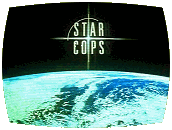 An accident aboard the Earth-to-Mars supply freighter Daedalus fires the ship’s engines long before they should, blasting the ship off-course. Its crew of two is doomed: while they’re in no danger of hitting anything, they’ll run out of air eventually. Even though the crew is still in contact, they’ve all but been declared dead already. The Star Cops begin an investigation, but Nathan has a distraction of his own: his girlfriend on Earth has been brutally murdered. When he arrives to personally assist in the investigation, he finds they he’s being treated as a suspect in the crime. This leaves David to spearhead the Daedalus investigation, during the course of which he makes a discovery that could save the crew’s lives: experimental cryogenic equipment is stored about the Daedalus that could be used to put the crew into hibernation, while there’s just enough fuel to put the Daedalus on a long course back home…if the airlocks are opened selectively. The problem is that it’ll take eight years for Daedalus to reach home, and until then nobody will know if the crew survived or not. And on Earth, Nathan receives a message stating that his girlfriend was but the first victim – and that he will be the next to die.
An accident aboard the Earth-to-Mars supply freighter Daedalus fires the ship’s engines long before they should, blasting the ship off-course. Its crew of two is doomed: while they’re in no danger of hitting anything, they’ll run out of air eventually. Even though the crew is still in contact, they’ve all but been declared dead already. The Star Cops begin an investigation, but Nathan has a distraction of his own: his girlfriend on Earth has been brutally murdered. When he arrives to personally assist in the investigation, he finds they he’s being treated as a suspect in the crime. This leaves David to spearhead the Daedalus investigation, during the course of which he makes a discovery that could save the crew’s lives: experimental cryogenic equipment is stored about the Daedalus that could be used to put the crew into hibernation, while there’s just enough fuel to put the Daedalus on a long course back home…if the airlocks are opened selectively. The problem is that it’ll take eight years for Daedalus to reach home, and until then nobody will know if the crew survived or not. And on Earth, Nathan receives a message stating that his girlfriend was but the first victim – and that he will be the next to die.
written by Chris Boucher
directed by Christopher Baker
music by Justin Hayward & Tony ViscontiCast: David Calder (Nathan Spring), Erick Ray Evans (David Theroux), Trevor Cooper (Colin Devis), Gennie Nevinson (Lee Jones), Sian Webber (Corman), Alan Downer (Paton), Sean Scanlan (Fox), Carmen Gomez (Gina), Benny Young (John Smith), Deborah Manship (Traffic Controller), Richard Ireson (Mike), Rosie Kerslake (Lara)
Notes: The last-ditch maneuver to save the Daedalus is based on a real scientific principle called a “free return trajectory”, a save-our-skins option that involves using the available fuel and possibly gravity assists from celestial bodies to put a spacecraft on track to return home with a minimum expenditure of resources. A free return trajectory often assumes that available fuel is at a minimum, due to whatever has forced mission planners to consider a free return trajectory in the first place. Apollo 13’s crew was successfully returned to Earth in 1970 by use of a free return trajectory that involved swinging around the moon.
LogBook entry by Earl Green
